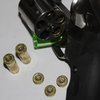Sample QL calc.
For a powder charge that generates full .357 mag pressure (35,000 psi), reducing the volume to a 38 Special case (0.1" shorter) would raise the pressure by about 10,000 psi to 45,000 psi due to the smaller volume of the case (+9 to +12,000 psi depending on the powder)
Now if you seated the bullet to where the OAL is the same for the 38 Special case as it is with the .357 magnum load (0.1" longer), you would get the same performance and same pressure as the .357 load in a .357 case. Yes, you lose a little neck tension because there is now less brass to grip the bullet while the powder ignites, but it's not much. However, you are likely not seated to where you could put a good roll crimp on the bullet which you would still need to prevent bullet setback in a tube magazine.
Best to stick with 38 +P loads if you're resigned to only use 38 special cases. Otherwise spring the bucks for some .357 brass.



